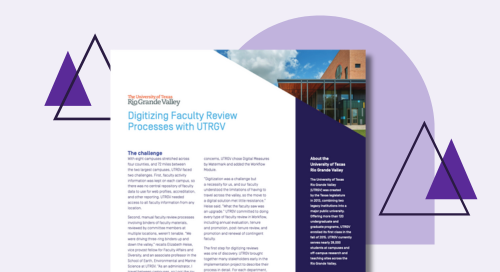The University of Texas Rio Grande Valley (UTRGV) was created by the Texas legislature in 2013, combining two legacy institutions into a major public university. Offering more than 120 undergraduate and graduate programs, UTRGV enrolled its first class in the fall of 2015. UTRGV currently serves nearly 28,000 students at campuses and off-campus research and teaching sites across the Rio Grande Valley.


With eight campuses stretched across four counties, and 72 miles between the two largest campuses, UTRGV faced two challenges. First, faculty activity information was kept on each campus, so there was no central repository of faculty data to use for web profiles, accreditation, and other reporting. UTRGV needed access to all faculty information from any location.
Second, manual faculty review processes involving binders of faculty materials, reviewed by committee members at multiple locations, weren’t tenable. “We were driving three-ring binders up and down the valley,” recalls Elizabeth Heise, vice provost fellow for Faculty Affairs and Diversity, and an associate professor in the School of Earth, Environmental and Marine Science at UTRGV. “As an administrator, I travel between campuses, so I got the joy of transporting binders. ‘Oh, you’re going to Brownsville tomorrow? Great! Can I have the keys to your car? I’ll fill your trunk with binders and I’ll have someone get them.’ My worst nightmare was that somebody was going to rear-end me on that freeway and all the paper in those binders would go flying. So binders weren’t working for us.”
UTRGV needed a software solution that captured faculty activities in a single database, and eliminated the need for binders while supporting the university’s many review processes. To address these concerns, UTRGV chose Digital Measures by Watermark and added the Workflow Module.
“Digitization was a challenge but a necessity for us, and our faculty understood the limitations of having to travel across the valley, so the move to a digital solution met little resistance,” Heise said. “What the faculty saw was an upgrade.” UTRGV committed to doing every type of faculty review in Workflow, including annual evaluation, tenure and promotion, post-tenure review, and promotion and renewal of contingent faculty.
The first step for digitizing reviews was one of discovery. UTRGV brought together many stakeholders early in the implementation project to describe their process in detail. For each department, “you need somebody who does every step of the process: a department chair, a dean, somebody from the provost’s office, and a committee reviewer, preferably someone who has been a committee chair,” Heise said. Capturing the perspective of all participants ensured that the review processes created in Workflow reflected the university’s documented review practices.
We didn’t realize that there were so many steps in a tenure and promotion process because everyone is sort of siloed in how they do things,” Heise said.A strong legacy, a stronger futureAbout the University of Texas Rio Grande ValleyThe University of Texas Rio Grande Valley (UTRGV) was created by the Texas legislature in 2013, combining two legacy institutions into a major public university. Offering more than 120 undergraduate and graduate programs, UTRGV enrolled its first class in the fall of 2015. UTRGV currently serves nearly 28,000 students at campuses and off-campus research and teaching sites across the Rio Grande Valley.
To validate what they’d learned, UTRGV built out every review process for the College of Business, which pilot tested Workflow. The insights gleaned from pilot testing allowed UTRGV to make adjustments, then successfully customize workflows for each type of review process for all of the other departments on campus.
The upfront work needed to set up review processes in Workflow paid off in several ways. “It’s amazing how fast the reviews are happening,” Heise said. “A process that used to take from September to January takes from September to October. We didn’t change any of the deadlines, but our completion is happening months before the deadlines, so we’re hitting the goals way ahead of time.”
Part of that speed comes from a profound improvement in the reviewer experience. “Reviewers tell us that reviews that would take four or five hours of searching through a binder for information has dropped down to about 30 to 40 minutes per review,” Heise said. “Our reviewers, especially department chairs and deans who have large volumes reviews to do, are enjoying having the extra time to do other tasks. So, that’s been a real win for all of us.”
In addition to efficiencies, UTRGV discovered a benefit of using Workflow that they hadn’t expected. “We compared what the policy said and found that our manual processes had some compliance issues that we weren’t aware of,” Heise said. “Workflow requires things to go where they’re supposed to go and not where people imagine they should go. We are now truly following our policy in all divisions and all departments, and that’s a real plus for us.”
Implementing a digitized system is a big task, but UTRGV is enthusiastic about the results. “Was it worth it? Absolutely,” Heise said. “We now have a complete faculty activity database. We gained consistency in reporting. In addition, we clarified all of our processes, and achieved compliance with them for the first time ever.”
UTRGV plans to digitize additional campus processes, including internal and external faculty award reviews, as well as faculty development leave, commonly called sabbatical. “We keep getting requests for more and more things we can do with Workflow, so we’re having to prioritize that list,” Heise said.

See how our tools are helping clients right now, get in-depth information on topics that matter, and stay up-to-date on trends in higher ed.